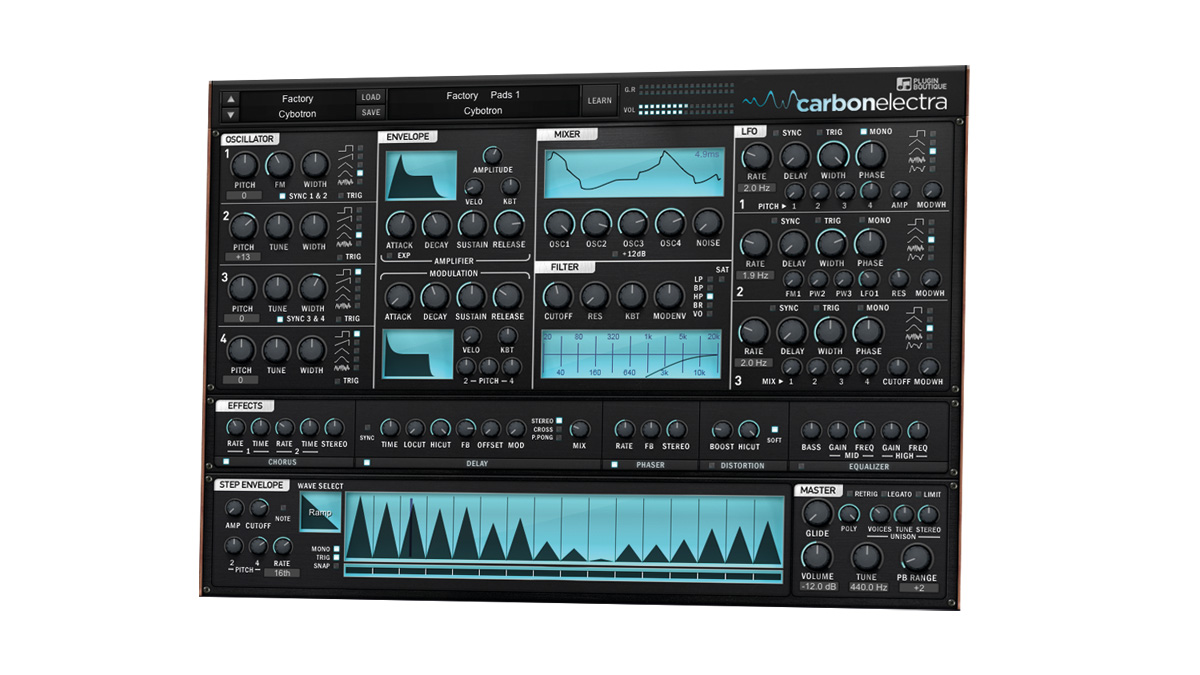MusicRadar Verdict
While it's never going to change the world of synthesis, Carbon Electra sounds gorgeous and is inspirationally easy to use.
Pros
- +
Easy one-screen interface. Four oscillators. Real-time waveform and filter displays. Over 600 presets.
Cons
- -
No dedicated arpeggiator. No modulation matrix.
MusicRadar's got your back
Carbon Electra (AU/VST) is a new subtractive synth plugin from Plugin Boutique, and with our reviews of its previous instruments being positively upbeat, expectations are high.
Operated via a one-screen interface with no hidden pages, highlights include four oscillators, five Effects modules and step-sequenced parameter modulation.
All four Oscillators can run any one of five waveforms (Pulse, Saw, Triangle, Sine and Noise), and feature pulse Width, Pitch (+/-36 semitones) and reset (Trig) controls, with fine-Tune (+/-50 cents) for Oscillators 2, 3 and 4. Oscillator 1 also gets frequency modulation, and Oscillators 2 and 4 can be synced to Oscillators 1 and 3, respectively.
Oscillator levels are balanced in the Mixer section, where you'll also find the level control for an additional white noise generator, and a +12dB level boost button, making it easier to overdrive the Filter.
The Filter itself is a resonant design with five modes - low-pass, band-pass, high-pass, band reject and vocal (formant) - and optional saturation. The Mixer and Filter each include real-time displays for the waveform and filter shape.
Both of Carbon Electra's two ADSR envelopes (Amplifier and Modulation) include adjustable keyboard and velocity tracking, while the amp envelope sports an exponential option for a more gradual attack shape, and a post- envelope-but-pre-Effects level control.
The Modulation envelope includes three dedicated Pitch assignments (Oscillator 2, 4 and all oscillators), and is also hardwired to the filter.
The three LFOs offer five waveshapes (Pulse, Ramp/Triangle, S-Curve/Sine, Filtered noise and S&H Noise/Ramp&Hold/Random), with shape variants dialled in with the Width control. Each one is hardwired to five fixed targets (so that's 15 targets in total), including oscillator pitch, pulse width, mixer levels, filter cutoff and resonance.
The Effects section's five modules comprise Chorus, Delay, Phaser, Distortion and Equalizer, between them delivering plenty of useful processing. The Master section includes Glide (0-4 seconds), Polyphony (1-16 voices), Unison (up to 4x) and output Limiter controls.
Electra-fied
Carbon Electra is very straightforward to program, so building sounds from the initialised preset is easy. Sonically, it's crisp and responsive, while the combination of four oscillators, unison and onboard effects make it more than up to the job of blasting out big, bold riff sounds. The hardwired modulation options are very effective, although a modulation matrix would, of course, be a welcome addition.
An important consideration with a synth like this is its presets, and Carbon Electra has over 600 of them, split between its categorised Factory library and Artist Presets, which include contributions from Carl Cox, Freemasons and many others.
The Leads and Pads categories are the highlights, featuring some excellently edgy sounds and dynamically evolving textures; but mention also needs to be made of the numerous Sequence and Effects patches, which really put the Step Envelope to work.
Lack of arpeggiator and modulation matrix aside, we have no major gripes, particularly given the price, and although there's certainly nothing game-changing here, Carbon Electra delivers awesome sounds with ease, which, for many, is what it's all about.
Computer Music magazine is the world’s best selling publication dedicated solely to making great music with your Mac or PC computer. Each issue it brings its lucky readers the best in cutting-edge tutorials, need-to-know, expert software reviews and even all the tools you actually need to make great music today, courtesy of our legendary CM Plugin Suite.
“I was like ‘Wow, Coldplay were definitely listening to Radiohead and trying to make their version of it’": Porter Robinson says that he only recently discovered that Coldplay used to sound a bit like Radiohead
Why is tennis superstar Serena Williams being bombarded with microphones fired from confetti cannons? Allow us to explain…
Carlos Santana collapses and then cancels second show “out of an abundance of caution”











